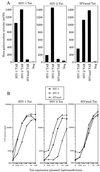Analysis of the effect of natural sequence variation in Tat and in cyclin T on the formation and RNA binding properties of Tat-cyclin T complexes
- PMID: 10364329
- PMCID: PMC112638
- DOI: 10.1128/JVI.73.7.5777-5786.1999
Analysis of the effect of natural sequence variation in Tat and in cyclin T on the formation and RNA binding properties of Tat-cyclin T complexes
Abstract
The biological activity of the human immunodeficiency virus type 1 (HIV-1) Tat (Tat1) transcriptional activator requires the recruitment of a Tat1-CyclinT1 (CycT1) complex to the TAR RNA target encoded within the viral long terminal repeat (LTR). While other primate immunodeficiency viruses, such as HIV-2 and mandrill simian immunodeficiency virus (SIVmnd), also encode Tat proteins that activate transcription via RNA targets, these proteins differ significantly, both from each other and from Tat1, in terms of their ability to activate transcription directed by LTR promoter elements found in different HIV and SIV isolates. Here, we show that CycT1 also serves as an essential cofactor for HIV-2 Tat (Tat2) and SIVmnd Tat (Tat-M) function. Moreover, the CycT1 complex formed by each Tat protein displays a distinct RNA target specificity that accurately predicts the level of activation observed with a particular LTR. While Tat2 and Tat-M share the ability of Tat1 to bind to CycT1, they differ from Tat1 in that they are also able to bind to the related but distinct CycT2. However, the resultant Tat-CycT2 complexes fail to bind TAR and are therefore abortive. Surprisingly, mutation of a single residue in CycT2 (asparagine 260 to cysteine) rescues the ability of CycT2 to bind Tat1 and also activates not only TAR binding by all three Tat-CycT2 complexes but also Tat function. Therefore, the RNA target specificity of different Tat-CycT1 complexes is modulated by natural sequence variation in both the viral Tat transcriptional activator and in the host cell CycT molecule recruited by Tat. Further, the RNA target specificity of the resultant Tat-CycT1 complex accurately predicts the ability of that complex to activate transcription from a given LTR promoter element.
Figures








References
-
- Arya S K, Beaver B, Jagodzinski L, Ensoli B, Kanki P J, Albert J, Fenyo E-M, Biberfeld G, Zagury J F, Laure F, Essex M, Norrby E, Wong-Staal F, Gallo R C. New human and simian HIV-related retroviruses possess functional transactivator (tat) gene. Nature. 1987;328:548–550. - PubMed
-
- Cullen B R. Use of eukaryotic expression technology in the functional analysis of cloned genes. Methods Enzymol. 1987;152:684–704. - PubMed
MeSH terms
Substances
LinkOut - more resources
Full Text Sources
Other Literature Sources
Molecular Biology Databases

